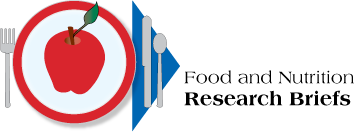This page has been archived and is being provided for reference purposes only. The page is no longer being updated, and therefore, links on the page may be invalid.
| October 2001 |
Packing Snacks With FiberIncreasing the dietary fiber from less than three to more than 10 percent in baked goods and snack foods is now possible. The best part is that consumers can get the added health benefit without tasting the difference. Studies suggest fiber can help decrease the risk of heart disease, some cancers, elevated blood pressure and diabetes. The recommended fiber intake is 20 to 35 grams daily, but Americans average only about 15 grams in their diets. ARS researchers found that by including dairy proteins such as casein or whey as a binder to hold everything together, they could also add more dietary fiber to bakery products, such as cookies and muffins, and to extruded products, such as breakfast cereals, corn puffs, cheese curls and energy bars. The texture of the higher-fiber foods was comparable to products currently on the market, researchers reported in Food Research International, 2001 (vol. 34, pp. 679-687). Extrusion is the process of forcing corn, wheat or rye flour and other ingredients through a die under high pressure, and sometimes heat, essentially cooking the mixture. Until now, it has been difficult to add cereal fibers during extrusion without causing an undesirable texture change, which then decreases consumer acceptance. Many extruded food products have less than one gram of fiber per 50 grams of product. But an "energy bar" prepared with the new process can contain as many as 15 grams in a 50-gram bar. In a separate project, the researchers use milk protein to envelope fiber and keep it from soaking up water when used in many foods. Reducing the water-holding capacity of the fiber improves food quality. A patent application has been filed on the process. For more information, contact Charles I. Onwulata, (215) 233-6497, Eastern Regional Research Center, Wyndmoor, PA Leptin May Help Quell Dieters' HungerDieters who have more of the hormonelike protein leptin circulating in their bodies may feel less hunger than dieters whose leptin levels drop while on a weight-loss regimen. That's according to a 15-week study of 12 overweight but otherwise healthy female volunteers age 20 to 40.
During the first week of the weight-loss stint, volunteers' plasma leptin levels dropped by an average of 54 percent. Then, levels remained low throughout the rest of the study. The incidence of hunger and the desire to eat doubled in response to the reducing diet. But the volunteers who reported the greatest increase in hunger and the greatest desire to eat were those with the largest drop in leptin. The findings were published in the American Journal of Clinical Nutrition, 1998 (vol. 68, pp. 794-801). By contrast, volunteers with higher leptin concentrations and smaller decreases in leptin as the study progressed were less hungry while dieting. The volunteers responded to a questionnaire once every two weeks throughout the study, ranking their hunger throughout the day. For more information, contact Nancy L. Keim, (530) 752-4163, Western Human Nutrition Research Center, Davis, CA Plant Estrogens Low for Older WomenThere is some evidence that natural, estrogenlike compounds in soybeans and many other plant foods may reduce hot flashes and vaginal dryness and increase bone density in women after menopause. But a careful inspection of the diets of nearly 1,000 older women in Massachusetts found their average intake of these phytoestrogens to be less than one milligram (mg) daily. That's only one to five percent of the phytoestrogen intake reported for Asian populations. Soybeans and soy protein products like tofu are concentrated sources of phytoestrogens and are common in Asian diets. By contrast, foods common in Western diets are far lower in these compounds. Epidemiologists at an ARS-supported center in Boston, Mass., collaborated on the study with researchers in The Netherlands, Finland and at Boston University School of Medicine. They estimated intakes of the three classes of phytoestrogens—isoflavones, lignans and coumestans—from food frequency questionnaires filled out by 964 postmenopausal, Caucasian women participating in the Framingham (Mass.) Offspring Study. In contrast to Asian populations, the U.S. women got the bulk of their phytoestrogens—nearly 0.6 mg—in the form of secoisolariciresinol from fruits, such as berries, citrus, apples and melon. The compound is one of the lignans, and it is most abundant in flaxseed. The better known isoflavones—genestein, daidzein and formononetin—provided about one-fourth of the phytoestrogens in the women's diets. And these came mostly from beans and peas rather than from soy products, the researchers reported in the Journal of Nutrition, 2001 (vol. 131, pp. 1826-1832). The third class of phytoestrogens, coumestans, were barely detectable in the women's diets. For more information, contact Paul F. Jacques, (617) 556-3322, Jean Mayer USDA Human Nutrition Research Center on Aging at Tufts University, Boston, MA More Potent Chromium Supplement on the HorizonNumerous studies have demonstrated that taking extra chromium daily in the form of a supplement may improve glucose tolerance in people whose blood sugar levels range from slightly elevated to full-blown diabetes. Now, ARS scientists have developed a new chromium formulation that people absorb into the bloodstream better than anything on the market. The new formulation is a complex of chromium and the amino acid histidine. It is absorbed at least 50 percent better than chromium picolinate—which was patented by other ARS scientists nearly three decades ago and is the best absorbed and most popular chromium supplement sold today. Histidine (not to be confused with histamine) is one of the "essential" amino acids because the body doesn't manufacture it. It is found in all meats and protein-containing foods Typical Western diets barely supply the new adequate intake (AI) for chromium--35 micrograms (mcg) daily for men, 25 mcg for women. And high sugar intakes, trauma and hard exercise can increase chromium excretion. Because the mineral improves insulin function, a shortfall can impair the cells' ability to remove excess sugar from the blood stream. However, chromium supplements won't help people who have high blood sugar in spite of getting adequate dietary chromium from good sources like liver, whole grains, nuts and meat. In tests, men and women absorbed an average 3.1 mcg of chromium from the chromium-histidine complex, compared with 1.8 mcg from chromium picolinate, 0.4 mcg from chromium chloride and 0.2 mcg from chromium polynicotinate. The latter two formulations are also popular supplements. The U.S. Department of Agriculture is seeking a patent on the chromium-histidine formulation, and the technology is available for licensing. In studies worldwide, supplemental chromium has improved blood sugar levels or other symptoms in people with glucose intolerance, type 1 and type 2 diabetes, steroid-induced diabetes, and gestational diabetes. For more information, contact Richard A. Anderson, (301) 504-8091, Beltsville Human Nutrition Research Center, Beltsville, MD Breakfast-Skippers Risk Iron Shortfall, Poorer GradesTeens who start their day without breakfast were twice as likely to have diets low in iron, according to a study involving more than 700 ninth graders in Louisiana. Nineteen percent of the ninth graders studied skipped breakfast, including 20 percent of white and 36 percent of non-white girls. What's more, the diets of one in three breakfast-dodgers had a significant iron shortfall—twice the rate of their breakfast-eating peers. That's a shortfall that could be hurting their grades. Iron-deficiency anemia has long been known to have a negative affect on behavior and learning. And, even marginal iron levels were linked to poorer math scores among adolescent girls in one recent study. In other studies, by contrast, eating breakfast has been shown to improve memory, grades, school attendance and punctuality in children. Teens who ate breakfast were two to five times more likely to consume at least two-thirds of the recommended amounts of most vitamins and minerals, including iron. Intakes of vitamins and minerals, including zinc, calcium and folic acid, were much higher among the breakfast-eaters, while fat consumption was lower. The nutrients teens miss when they skip breakfast are rarely recouped during other meals, according to the researcher, who published her results in the Journal of Adolescent Health, 2000 (vol. 27, pp. 314-321). Girls, in particular, are at risk for low iron because they have increased needs. And while some teens skip breakfast to cut calories, this practice is rarely effective. Instead, research suggests that meal-skippers often eat more high-calorie, salty and low-fiber snacks. For more information, contact Theresa Nicklas, (713) 798-7000, Children's Nutrition Research Center at Baylor College of Medicine, Houston, TX Low-Fat French Fries From Rice?An ARS scientist is cooking up a new kind of french fry for health-conscious consumers who simply can't resist the fast-food favorite. Because the fries are made from rice flour mixtures, rather than potatoes, they absorb less fat during cooking. Rice is also hypoallergenic, nutritious and easily digested, and it stores well. The fries are made with broken and immature/thin rice kernels, which fetch a lower price than regular whole rice. The method, which overcomes technical difficulties experienced by earlier scientists, processes rice flour mixtures into fries with texture, cooking and other properties that closely mimic potato fries. Details of the research leading up to the process appear in the Journal of Food Science, 2001 (vol. 66 (4), pp. 610-613 and vol. 66 (8), pp. 1084-1088). In tests, the rice fries generally absorbed 25-50 percent less fat from oil during cooking than potato fries. They could also be made into a "functional food," since they can be fortified with vitamins, minerals, protein and other nutrients. The U.S. Department of Agriculture filed for a patent on the process. Now, the ARS researcher and collaborators with Rishellco, Inc., are consulting with U.S. rice processors on ways to commercialize the fries. In related work, the researcher is experimenting with a whole-rice bread for individuals with celiac disease, an intolerance to the wheat protein gluten that affects one to two percent of the U.S. population. For more information, contact Ranjit Kadan, (504) 286-4332, Southern Regional Research Center, New Orleans, LA Lower Trans-Fats Foods in the MillMargarine and other foods can be made with a lower percentage of trans fats with a new hydrogenation process developed by ARS scientists. Using a hydrogenation process with carbon dioxide makes a product with less than 10 percent trans fatty acid content that's suitable for use in margarine and other tablespread formulations. This is good news for consumers because studies have shown that trans fatty acids may slightly increase blood cholesterol levels. Margarine oils are usually prepared using hydrogenation or by another conventional method, interesterification. Hydrogenation changes the chemical structure of oils to yield a margarine that doesn't melt at room temperature. But the product contains 10 to 30 percent trans fatty acids. The new hydrogenation process also alters the chemical bonds of vegetable oil, but it produces an oil with a much lower percentage of trans fatty acids. The researchers are currently seeking an industry partner to continue this development, which is described in the Journal of the American Oil Chemists' Society, 2001 (vol. 78, pp. 107-113). Interesterification rearranges the oil's fat molecules without adding hydrogen molecules, yielding a product with few trans fatty acids. Its drawback is that the process is more expensive than hydrogenation. For more information, contact Gary R. List, (309) 681-6388, National Center for Agricultural Utilization Research, Peoria, IL How Much Antioxidant Protection Do You Really Have?The orange and red plant pigments beta carotene and lycopene score high as antioxidants in the test tube. But their antioxidant capacity has seemed to disappear in human blood. Not any more. A new assay that peers into blood lipids shows that these antioxidant nutrients have been doing their job in our blood all along. Beta carotene, lycopene and other fat-soluble antioxidants hang out in the lipid portion of human plasma. But popular assays measure antioxidant capacity of the water portion only, where vitamin C and other water-soluble antioxidants settle. Oxidation events generally begin there, but the chain reactions they set off readily cross over into the lipid portion of plasma and vice versa. The new assay, which measures oxidation in both environments, gives a truer picture of total antioxidant capacity of biological samples. It was developed by researchers at an ARS-supported center in Boston, Mass., and the University of Milan, Italy. Ultimately, the assay will help health professionals better recommend the antioxidants an individual needs to boost protection against heart disease, cancer and other age-related diseases. These are believed to evolve, in large part, from cumulative oxidative damage to cell components. Named SOLAC—for selective oxidizability of lipid and aqueous compartments—the assay appears in the October issue of Free Radical Biology & Medicine, 2001 (vol. 31, pp. 1043-1050). The researchers are gearing up to assay plasma samples from two large-scale population studies to look for correlations between true antioxidant capacity and heart disease or eye disease. If they find correlations, results from SOLAC could serve as a biomarker for risk of these diseases. For more information, contact Kyung-Jin Yeum, (617) 556-3128, Jean Mayer USDA Human Nutrition Research Center on Aging at Tufts University, Boston, MA Technology Exposes Fecal Contamination on BeefA fecal detection system, capable of scanning an entire beef carcass, can help the meatpacking industry supply safe food products to U.S. and foreign consumers. ARS and Iowa State University scientists developed and patented the technology that's exclusively licensed by eMerge Interactive, Inc., Sebastian, Fla. Under a cooperative research and development agreement, optical and electronic engineers at eMerge are using the technology in prototypes that could prove practical for the beef packing industry. Visual inspection and carcass cleaning are standard tools for reducing the potential for carcasses to become contaminated with E. coli and other pathogenic bacteria carried in feces. But the human eye is not sensitive enough to identify all of the fecal contamination that can occur on carcasses. In a recent trial of an eMerge prototype, the new detection system revealed trace levels of fecal contamination that were invisible to the human eye. The prototype was also successful in evaluating fecal decontamination of carcasses treated with high-temperature steam, a common practice. For more information, contact Thomas A. Casey, (515) 663-7726, National Animal Disease Center, Ames, IA What Makes Foodborne Pathogens Stick?ARS scientists are snooping into the secret tricks that food-poisoning organisms use when they grab onto a surface such as chicken skin. Their studies may lead to new, safe and effective ways to thwart pathogenic microorganisms such as Campylobacter, which alone causes an estimated 2 million illnesses, 10,000 hospitalizations and 100 deaths a year in this country.
In a test with 12 Campylobacter strains, the scientists found that all of the strains bound to proteoglycans within about two minutes and, in about 20 minutes, formed large colonies. In another test, the scientists showed that eight of nine Campylobacter strains, when exposed to a mixture of chicken-skin phospholipids, bound to a phospholipid known as sphingomyelin. Other scientists have already speculated that proteins or fats in meats may act as receptors. The Albany investigations provide new evidence that proteoglycans and phospholipids probably play that role in poultry and show the speed with which the microbe can attach to receptors that it apparently prefers. For more information, contact Robert E. Mandrell, (510) 559-5829, Western Regional Research Center, Albany, CA |
|
The United States Department of Agriculture (USDA) prohibits discrimination in all its programs and activities on the basis of race, color, national origin, gender, religion, age, disability, political beliefs, sexual orientation, and marital or family status. (Not all prohibited bases apply to all programs.) Persons with disabilities who require alternative means for communication of program information (Braille, large print, audiotape, etc.) should contact USDA's TARGET Center at 202-720-2600 (voice and TDD). To file a complaint of discrimination, write USDA, Director, Office of Civil Rights, Room 326-W, Whitten Building, 14th and Independence Ave., SW, Washington, DC 20250-9410 or call 202-720-5964 (voice or TDD). USDA is an equal opportunity provider and employer. |


 Conducted by ARS and University of California-Davis researchers, the study is among the first long-term analyses of blood leptin in women who are on a reducing diet. The findings should help obesity researchers and others determine whether leptin can be used effectively to help people shed extra pounds.
Conducted by ARS and University of California-Davis researchers, the study is among the first long-term analyses of blood leptin in women who are on a reducing diet. The findings should help obesity researchers and others determine whether leptin can be used effectively to help people shed extra pounds. Studies of C. jejuni, the most troublesome of the Campylobacter species, will help scientists determine how the microbe's genes interact with molecules known as receptors. Proteins called proteoglycans and fat-containing compounds called phospholipids likely serve as receptors, according to preliminary experiments.
Studies of C. jejuni, the most troublesome of the Campylobacter species, will help scientists determine how the microbe's genes interact with molecules known as receptors. Proteins called proteoglycans and fat-containing compounds called phospholipids likely serve as receptors, according to preliminary experiments.